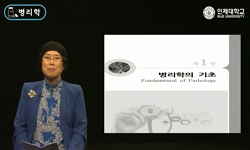상괭이(Neophocaena asiaeorientalis)는 동아시아에 분포하는 소형 쇠돌고래이다. 최근 그 개체수가 급감하며 멸종위기종으로 분류되고 있다. 한국 바다는 현재 가장 많은 수의 상괭이가 서식하는 ...
http://chineseinput.net/에서 pinyin(병음)방식으로 중국어를 변환할 수 있습니다.
변환된 중국어를 복사하여 사용하시면 됩니다.
- 中文 을 입력하시려면 zhongwen을 입력하시고 space를누르시면됩니다.
- 北京 을 입력하시려면 beijing을 입력하시고 space를 누르시면 됩니다.
Endo-parasites and pathologic findings in narrow-ridged finless porpoise (Neophocaena asiaeorientalis) habiting in Korean seas
한글로보기https://www.riss.kr/link?id=T15687518
- 저자
-
발행사항
서울 : 서울대학교 대학원, 2020
-
학위논문사항
학위논문(박사) -- 서울대학교 대학원 , 수의학과 수의병인생물학 및 예방생물학전공 , 2020. 8
-
발행연도
2020
-
작성언어
영어
-
주제어
Parasite ; Parasitology ; Narrow-ridged finless porpoise ; Neophocaena asiaeorientalis ; Cetacean ; Pathology ; Genetic ; Anisakis ; 기생충 ; 기생충학 ; 상괭이 ; 고래 ; 병리학 ; 아니사키스 ; 계통지리학
-
DDC
636.089 판사항(22)
-
발행국(도시)
서울
-
기타서명
한국 바다에 서식하는 상괭이의 내부기생충 감염 현황 및 병리학적 소견
-
형태사항
xii, 198 p. : 삽화, 표 ; 26 cm
-
일반주기명
참고문헌 수록
-
UCI식별코드
I804:11032-000000163469
- 소장기관
-
0
상세조회 -
0
다운로드
부가정보
국문 초록 (Abstract)
상괭이(Neophocaena asiaeorientalis)는 동아시아에 분포하는 소형 쇠돌고래이다. 최근 그 개체수가 급감하며 멸종위기종으로 분류되고 있다. 한국 바다는 현재 가장 많은 수의 상괭이가 서식하는 곳으로 최근 몇 년간 종 보전을 위한 여러 연구가 수행되어 왔다. 하지만 상괭이의 감염성 질병에 대한 국내 연구는 전무한 상황이다. 상괭이의 기생충성 질병에 대한 분석을 위해 2016년부터 2019년까지 4년 동안 총 107마리의 상괭이를 부검하여 여러 장기의 내부기생충을 채집하였다. 이 기생충들을 기생 부위별로 나누어 형태학적, 유전학적인 방법으로 종 동정을 실시하였다. 총 8종의 선충 (Parurus asiaeorientalis, P. sunameri, Stenurus nanjingensis, Halocercus pingi, H. sunameri, H. taurica, Anisakis pegreffii and Crassicauda magna)과 6종의 흡충 (Nasitrema sunameri, N. spathulatum, N. dalli, Campula oblonga, Synthesium tursionis and S. nipponicum)과 한 종의 조충 (Diphyllobothrium fuhrmanni)이 동정되었다. 이 중 N. dalli와 S. nipponicum은 상괭이 감염의 첫 보고이다. 각 기생충의 유병률은 숙주의 체장, 즉 성장 단계과 유의미한 관련이 있었으며, 이를 통해 H. pingi와 Crassicauda를 제외한 모든 종이 먹이원을 통해 감염되는 것으로 추정된다. 동, 남, 서해의 세 지역에 따른 유병률 차이 및 성별에 따른 유병률 차이는 모든 종에서 유의하지 않은 것으로 드러났다 (P>0.05).
기생충 감염은 숙주의 건강 상태, 질병, 좌초 행동 및 더 나아가 집단의 생존에 영향을 미칠 수 있다. 멸종 위기인 상괭이의 종 보전을 위해 기생충이 숙주에 미치는 영향을 정확히 판단하는 것은 매우 중요하다. 내부 기생충 감염으로 인한 병리적 병변이 발생한 조직에 대하여 육안 및 조직학적 분석을 실시한 결과, 위에서는 궤양, 미란, 출혈, 울혈, 색소 침착, 점막 비후, 박리, 경화, 천공과 과각화 및 위염 등의 다양한 증상이 발견되었다. 간에서는 육아종성 병변 및 담관 벽 비후가 주로 나타났으며, 유선에서는 결절 및 선충 감염에 의한 것으로 추정되는 상피근종 소견이 보였다. 폐에 기생하는 선충은 석회화 결절, 울혈, 기종, 수종 등의 육안적 소견과 기관지 폐렴 및 다발성 기관지염 등의 조직병리학적 소견을 보였다. 이 중 Halocercus pingi는 어미로부터 수직감염되는 것으로 추정되며, 중감염되는 경우 신생 동물의 호흡을 방해해 생존에 치명적인 영향을 미치는 것으로 판단된다. 이 종의 정확한 감염 기전을 밝히기 위해서는 태아에의 감염 또는 유즙 내 충란의 존재를 확인해야 한다. 기생충이 숙주에 미치는 병리적 영향에 대한 보다 정확한 분석을 위해서는 각 기생충의 정확한 생활사 규명이 수반되어야 할 것이다.
바다에 서식하는 기생충 중 가장 많은 연구가 이루어져 비교적 그 정보가 많은 아니사키스 종에 대한 계통분류학적, 계통지리학적 분석을 실시하였다. 동해, 남해 및 서해의 세 해역에서 수집한 상괭이의 위에서 검출된 아니사키스는 모두 Anisakis pegreffii로 동정되었다. 각 해역별로 30마리씩, 총 90마리의 A. pegreffii 세 유전자 (ITS, rrnS 및 cox2) 시퀀스를 분석한 결과, 두 종류의 미토콘드리아 유전자 (rrnS, cox2)의 유전적 다양성은 높은 편이나 핵 유전자 (ITS)는 단 하나의 하플로타입을 나타내었다. 세 해역간의 집단 구조는 없는 것으로 밝혀졌다. 다양한 숙주를 가지는 아니사키스의 간접 생활사 및 세 해역을 분리할만한 지형적 장애물이 없는 지리적 특징이 아니사키스의 유전자 흐름을 원활하게 하는 요인으로 분석된다. 보다 정확한 요인 분석을 위해 아니사키스 속의 중간숙주인 어류, 두족류 및 종숙주인 다른 해양 포유류의 국내 아니사키스 감염 현황에 대한 종합적인 연구가 추가적으로 이루어져야 할 것으로 생각된다. 세 유전자 중 분화 정도가 가장 높은 미토콘드리아 cox2 유전자를 Genbank에 등록된 세계 여러 해역의 하플로타입과 비교 분석하였다. 그 결과, 한국을 포함한 전 세계의 하플로타입은 크게 두 그룹으로 나뉘었으며 물리적 거리에 비례하는 유전적 거리와 panmixia가 동시에 나타나는 경향을 보였다.
한국 바다에 서식하는 상괭이의 내부기생충을 동정하고 숙주의 성장 단계, 성별 및 서식 해역에 따른 유병률을 조사하여 전체적인 감염 현황을 정리하였다. 상괭이의 위, 장, 간, 폐, 두개골 내 공간, 유선 및 근육 등 다양한 내부 장기에는 선충, 흡충 및 조충이 감염되어 있었다. 대부분의 기생충들은 성장 단계에 따라 식이성으로 감염되는 것으로 확인되었다. 몇 종의 기생충은 상괭이의 건강 상태에 위협이 되고 있다. 멸종 위기에 처한 상괭이의 종 보전을 위해 보다 광범위하고 체계적이며 지속적인 모니터링이 절실히 필요하다.
다국어 초록 (Multilingual Abstract)
The narrow-ridged finless porpoise (Neophocaena asiaeorientalis) is a small porpoise distributed in East Asia from Taiwan to Japan. The largest number of narrow-ridged finless porpoises inhabit the Korean seas. Several studies were performed to aid t...
The narrow-ridged finless porpoise (Neophocaena asiaeorientalis) is a small porpoise distributed in East Asia from Taiwan to Japan. The largest number of narrow-ridged finless porpoises inhabit the Korean seas. Several studies were performed to aid the conservation of the species there. However, research on infectious diseases was not performed for this species in Korea. Therefore, parasitic infestations in this species were studied as the first step of research on infectious diseases in narrow-ridged finless porpoises captured in the seas around the Korean peninsula.
The narrow-ridged finless porpoises are classified as an endangered species because the population has recently declined sharply in all the countries they inhabit, including Korea, Japan, and China. The purpose of this study is to collect basic biological information about the species which is the most numerous and common in Korean seas, using analyses of parasites as an ecological indicator.
During five years (2016 - 2019), a total of 107 narrow-ridged finless porpoises were dissected to examine parasitogenic diseases. The endo-parasites were collected from their organs and tissues during dissection. The collected parasites were classified according to the collected organ, morphological characteristics, and phylogenetic groups. Eight species of nematodes (Parurus asiaeorientalis, P. sunameri, Stenurus nanjingensis, Halocercus pingi, H. sunameri, H. taurica, Anisakis pegreffii and Crassicauda magna) and six species of trematodes (Nasitrema sunameri, N. spathulatum, N. dalli, Campula oblonga, Synthesium tursionis and S. nipponicum) and one cestode species (Diphyllobothrium fuhrmanni) were identified. Two trematodes, N. dalli and S. nipponicum, were first recorded from this porpoise species in this study. The parasite prevalence was significantly related with total body length of the host (in terms of growth stage), suggesting that the porpoise are infected with the parasites except H. pingi and C. magna, through taking food in the seas. The relationship between prevalence of the parasites and sea sector or host sex was not statistically significant (p>0.05).
The parasitic infections in the narrow-ridged finless porpoise should be comprehensively surveyed to conserve more effectively this endangered species. The parasitic infections caused gross and pathological lesions in the stomach such as ulcer, erosion, hemorrhage, congestion, mottled macular pigmentation, mucosal hypertrophy, desquamation, solidification, perforation, hyperparakeratosis, and gastritis. In the liver, granuloma and hyperplasia of the bile duct wall were frequently observed. In the mammary glands, solid nodules and myoepithelioma were found. Lung nematodes were found provking the calcified nodules, congestions, emphysema and edema and also histopathological lesions such as bronchopneumonia and multifocal bronchitis. The lungworm, H. pingi was considered to be infected vertically from dam to fetus or calf. When heavily infected, it could be lethal to the neonates by disturbing breathing. To elucidate a mode of infection of this species, infection in fetus and/or existence of eggs in milk of the dam should be investigated. The complete life cycle of each parasite should be investigated for a more accurate examination of the pathological effect on the host species.
Phylogenetic and phylogeographical analyses of Anisakis which has been intensively studied compared with other marine parasites were carried out. All nematodes from the stomachs of narrow-ridged finless porpoises inhabiting the three sea sectors of the Korean peninsula—the East sea, the Southern sea, and the Yellow sea—were identified as A. pegreffii. Three genes of 30 worms each from the sea, 90 worms in total were sequenced and analyzed. The mitochondrial genes were highly diverse, while the nuclear genes were conserved, showing only one haplotype in one gene. No genetic population structure among the three sea sectors was found. The indirect life cycle of A. pegreffii which has various intermediate and definitive hosts was analyzed as the factors that facilitate gene flow of A. pegreffii. The topographical features of Korean waters, which have no geographical barrier to separate the three seas were also could make high gene flow of A. pegreffii. A more accurate factor analyses would require a comprehensive examination of the infectious status of the genus Anisakis in other species, including fishes and cephalopods as intermediate hosts, and other final cetacean hosts. The most differentiated gene among the three genes, mitochondrial cox2 gene were compared with haplotypes from worldwide oceans registered in Genbank. The haplotypes of worldwide oceans including the Korean haplotypes from this study were largely divided into two groups. Both of genetic distance related to geographical distance and panmixia of haplotypes were observed.
Collectively, this study clarified infection status of the endo-parasites in the narrow-ridged finless porpoises in Korean seas. The narrow-ridged finless porpoises were infected with nematodes, trematodes and cestode in various internal organs. Most of the helminth species were found to infect to the hosts by preying related to growth stage. Several parasite species were found to be fatal to the health status of the narrow-ridged finless porpoises. More extensive, systematic and continuous monitoring are strongly needed for conservation of the species.
목차 (Table of Contents)
- General Introduction 1
- Literature Review 5
- A. Cetacean 5
- B. Narrow-ridged finless porpoise 6
- General Introduction 1
- Literature Review 5
- A. Cetacean 5
- B. Narrow-ridged finless porpoise 6
- C. Parasites of marine mammals 10
- C.1. Morphological studies 10
- C.2. Pathological studies: 11
- C.3. Genetic studies: 12
- D. Parasites of narrow-ridged finless porpoise 19
- CHAPTER Ⅰ: Endo-parasites of narrow-ridged finless porpoise (Neophocaena asiaeorientalis) inhabiting three sea sectors of the Korean peninsula 21
- Abstract 22
- 1.1. Introduction 24
- 1.2. Materials and Method 26
- 1.2.1. Sample collection 26
- 1.2.2. Identification of endo-parasites 32
- 1.2.3. Genetic identification 34
- 1.2.3.1. Extraction of Genomic DNA 39
- 1.2.3.2. PCR amplification 39
- 1.3. Results 47
- 1.3.1. Collection of endo-parasites from internal organs 47
- 1.3.2. Morphological identification and prevalence 50
- 1.3.3. Genetic identification from sequence analyses at multiple gene 58
- 1.4. Discussion 71
- 1.5. Conclusion 83
- CHAPTER Ⅱ: Gross and histopathological findings in the organs infected with endo-parasites in narrow-ridged finless porpoise in Korean seas. 84
- Abstract 85
- 2.1. Introduction 88
- 2.2. Materials and Method 91
- 2.3. Results 93
- 2.3.1. Gross Pathology 93
- 2.3.2. Histopathology 104
- 2.4. Discussion 113
- CHAPTER Ⅲ: Phylogenetical and phylogeographical analyses of Anisakis pegreffii found in stomach of narrow-ridged finless porpoise in Korean seas. 117
- Abstract 118
- 3.1. Introduction 120
- 3.2. Materials and Method 123
- 3.3. Results 126
- 3.3.1. Genetic diversity 126
- 3.3.2. phylogeny and phylogeography 131
- 3.4. Discussion 147
- General Conclusion 157
- References 160
- 국 문 초 록 195













